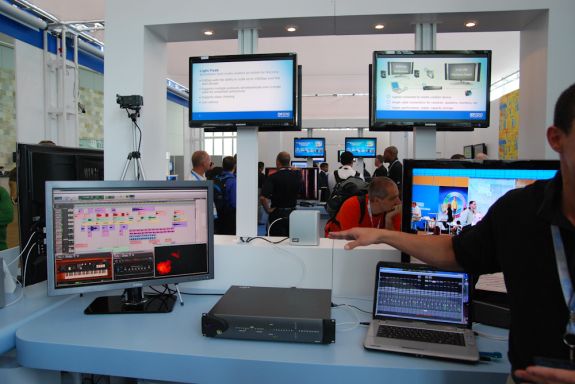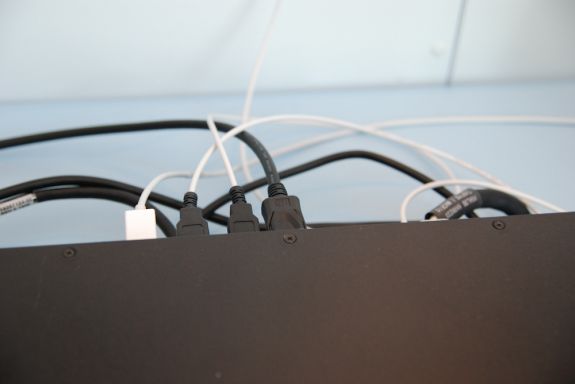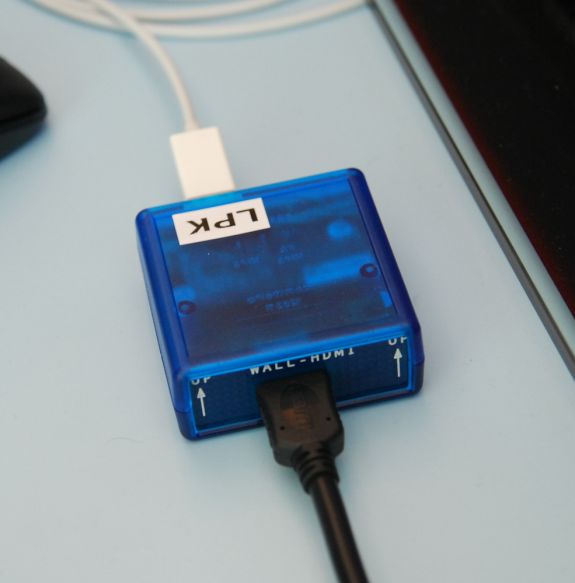Intel Light Peak - Lighting up 10 Gbps links in 2011
by Brian Klug on September 16, 2010 3:40 PM EST- Posted in
- Trade Shows
- Intel
- LightPeak
First off, Light Peak speeds remain the same as we've previously seen at 10 gigabits/s, though opportunity to scale to 100 gigabits/s remains a promise for the future. Intel had two demonstrations setup illustrating Light Peak's potential as a bus for huge amounts of traffic. First up was a Compal notebook connected to an Avid HD I/O box, which was in turn connected to two more devices. An external Western Digital dual drive solution with a Light Peak connector, and an HDMI adapter driving 1080P video content.
According to Intel, Light Peak enabled Avid to move mixing control to the Compal notebook software suite. Bandwidth is now sufficient to pass uncompressed extremely high sampling rate audio streams between the notebook and the Avid HD I/O box.
All of those white cables coming out of the Avid box on the left side are Light Peak. Note that they look a lot like USB - more on that in a moment. Light Peak connects the Avid HD I/O box and its lossless audio streams, a raw 1080P HDMI video stream, Western Digital external hard drive, and another uncompressed video played back on the Dell LCD to the left in this demo. This demo is clearly targeted at selling studio artists on Light Peak.
The Light Peak to HDMI converter box has also shrunk considerably. It's now a bit smaller in profile than a credit card:
There's no external power adapter here either, just Light Peak to HDMI for the TV. The Compal notebook has been shown around a bit before, but the connection is again seamlessly integrated into the notebook by all appearances. Check out the gallery for all the pics from this demo:



















59 Comments
View All Comments
JoKeRr - Thursday, September 16, 2010 - link
wouldn't be surprised if Apple drove the whole lightpeak initiative as the technology choice here makes no sense.why would intel use VCSEL laser? those usually have good linewidth characteristics but a lot more expensive than DFBs and other cheaper types. For 10Gbps, you can easily directly modulate a DFB and get good reach. I suspect with VCSEL laser, there's a need for an external modulator which makes it a lot more expensive. Also on the topic of WDM, right now ppl are doing >40Gbps and 100Gbps with single wavelength, going wdm with 10gig is just a bad choice. The use of multimode fiber is not the best either. Corning already has bendable (very tight radius) single mode fiber, going multimode just create extra problems with modal dispersion and definitely requires a better receiver -> more expensive.
ya smells like a bad apple to me.
name99 - Thursday, September 16, 2010 - link
Hmm. So let me get this right.You hate the choice of a VCSEL laser because DFB would be cheaper (but not as good tech).
And you hate the choice of multimode even though IT is cheaper than single mode, because it is not as good tech.
Why not just come out straight and say that you hate this because it was spearheaded by Apple, nothing to do with the details of the tech, you just hate anything associated with Apple? Don't waste our time with your pseudo-scientific teardown of the tech when those details have fsckall to do with your actual feelings.
JoKeRr - Friday, September 17, 2010 - link
I actually work in optical communication industry and I build optical modems. Yes DFB is cheaper than VCSEL mainly b/c it's been around a lot longer and the manufacturing process is a lot more refined. Multimode is actually quite a bit more expensive than single mode, simply b/c it needs more glass. Ask anyone from corning if you don't believe me. I never said multimode is cheaper, I did say a more expensive receiver is required if you use multimode fiber. So essentially every component choice made in Light Peak is expensive. Is that enough to convince you or your ego?As to RaynorWolfcastle's comment, connector alignment with SMF is really no issue with the standardization of SC or FC connector, and the bendable single mode fiber is still cheaper than the equivalent multimode. Only real problem is keeping the SMF core clean to get enough signal sensitivity.
RaynorWolfcastle - Thursday, September 16, 2010 - link
Intel uses directly modulated VCSELs, though I can't remember where I read this (Light Reading, maybe?). I believe that VCSELs are also more die-space efficient than DFBs since they have (by definition) a vertical cavity vs the DFB's horizontal cavity.Secondly, it is very obvious that they would want multimode fiber for easier alignment and cheaper connectors. Dispersion is not really a concern over such short distances (tens of meters) anyways. Corning's photonic crystal fiber is also expensive.
You're really looking at this from a performance point of view instead of looking at it from a cost-reduction point of view. They're not looking to generate clean PSK signals over kms of fiber here, they want cheap connectors with cheap cables that can be used without any fuss by a sexagenarian.
As an aside, I really think the connector issue is a much bigger one than the article lets on. Making connectors that align well for pennies will be challenging.
DigitalFreak - Thursday, September 16, 2010 - link
"A whole article on Light Peak and nothing related to Apple?"Waaaaaaa
Stahn Aileron - Thursday, September 16, 2010 - link
No offense, but was the author half-asleep while writing this? I see many grammar errors in this piece...Frankly, the writing in this article is lower than what I usually see and expect from Anandtech."All together, the vision is enabling creation enabling the Compal notebook to control mixing on the Avid HD I/O box."
"All total, Light Peak carried uncompressed audio mixed..."
Brian Klug - Thursday, September 16, 2010 - link
I actually was half asleep, around 1:00 AM ;)Fixing those now!
-Brian
numberoneoppa - Thursday, September 16, 2010 - link
Haha, Brian. <3SteelCity1981 - Thursday, September 16, 2010 - link
So this is why Intel has kept putting native USB 3.0 support on the back burner.Roland00 - Thursday, September 16, 2010 - link
In theory it can work. But what are the chances of this causing an aftermarket vendor to make external video cards? This would be great both for laptops (so you can have battery life and speed when you need) and make it less scary for people to upgrade their video cards in their desktops.